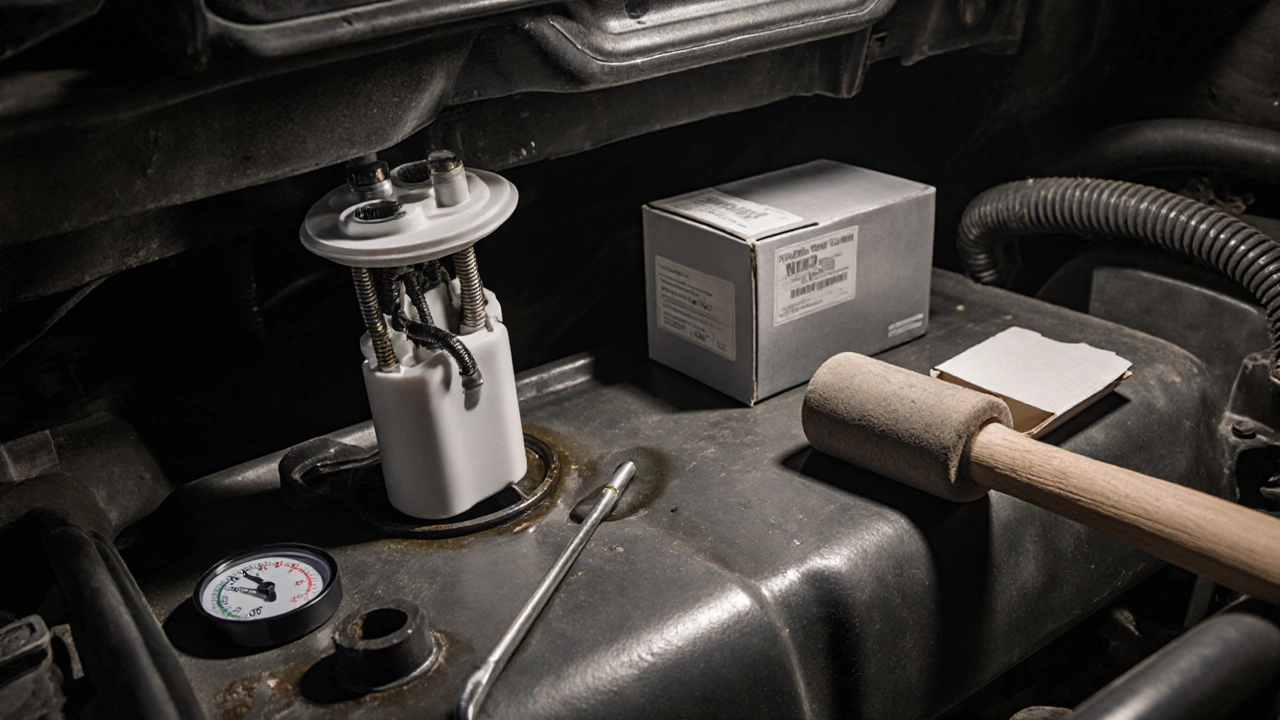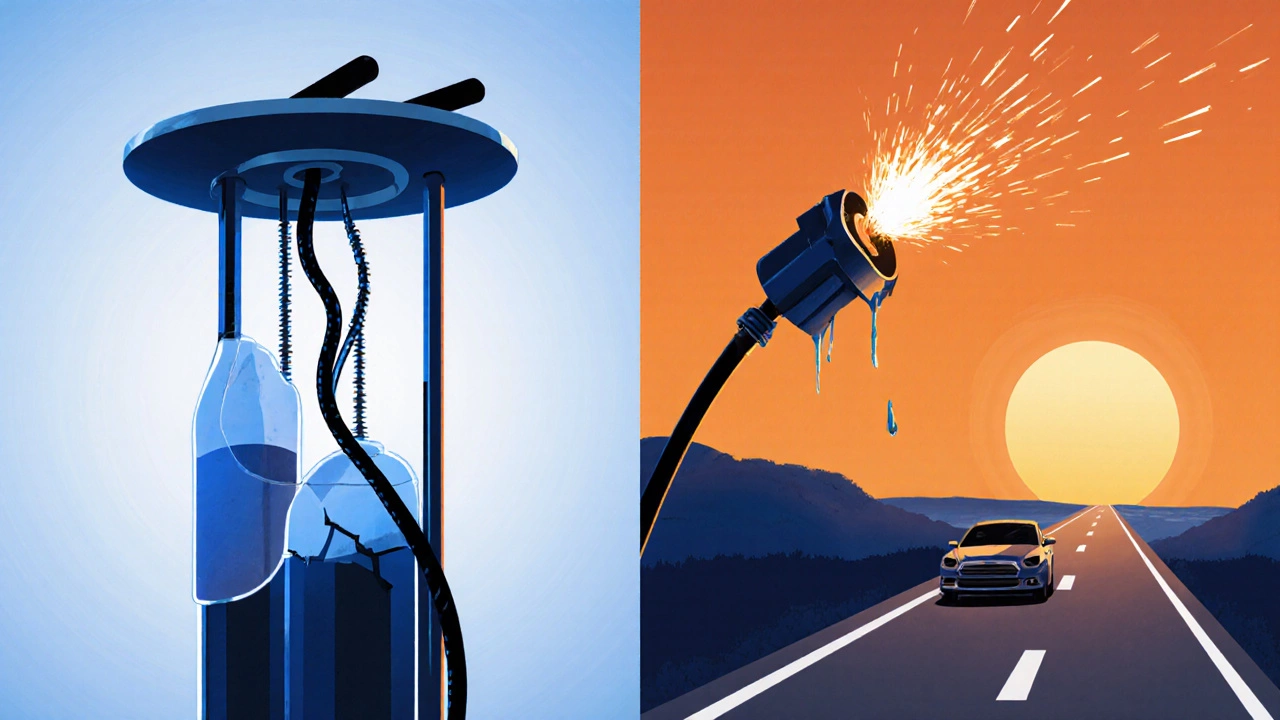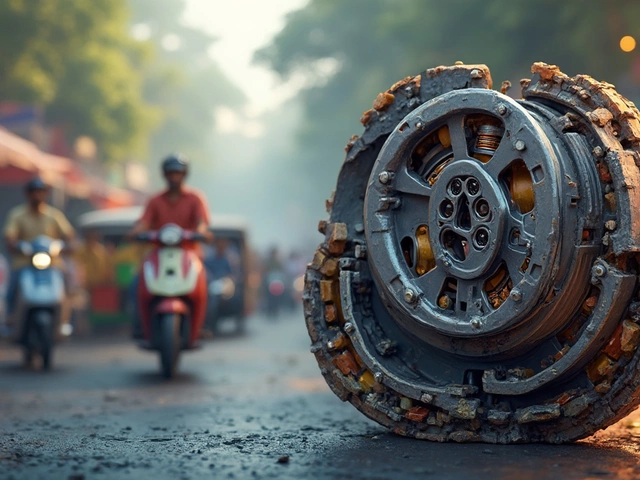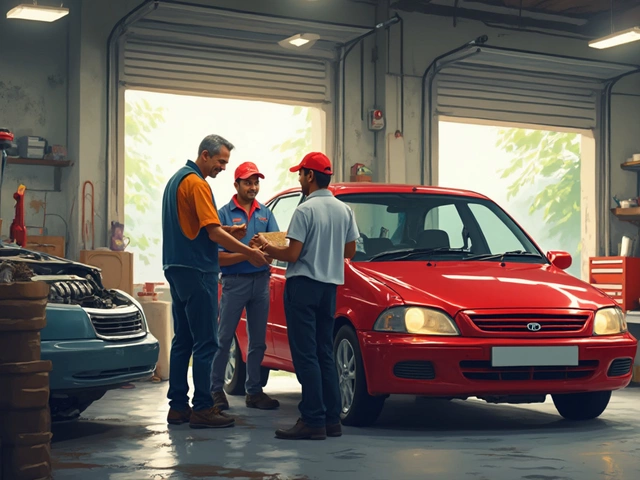If your car sputters on the highway, struggles to start after sitting overnight, or loses power when you step on the gas, it might not be your spark plugs or battery-it could be your fuel pump. Fuel pumps don’t usually give you a warning before they die. They just stop working, often when you’re far from home. Knowing the signs early can save you from being stranded or paying for a tow truck.
Engine Won’t Start or Takes Too Long to Turn Over
When you turn the key and hear nothing but a clicking noise, most people blame the battery. But if the battery is fine-checked with a multimeter and showing 12.6 volts or higher-and the engine still won’t crank, the fuel pump could be the culprit. A failing pump can’t build enough pressure to deliver fuel to the injectors. You might hear a faint whining noise from the back of the car when you turn the ignition on, but no fuel is actually getting through.
Try this: turn the key to the ‘on’ position without starting the engine. Wait five seconds. You should hear a brief hum from the fuel tank area. That’s the pump priming the system. If you hear nothing, the pump might be dead. If you hear a weak buzz or a stuttering sound, it’s struggling.
Engine Sputters or Stalls at High Speeds
Imagine you’re cruising at 100 km/h on the freeway, everything’s smooth-then the engine stutters like it’s running out of gas. You ease off the pedal, and it catches again. Repeat this a few times, and you’re likely dealing with a fuel pump that can’t keep up under load.
Fuel pumps are designed to deliver a steady flow of fuel, even under high demand. When the internal motor wears out or the filter inside the pump gets clogged, it can’t push enough fuel when the engine needs it most. This isn’t a fuel filter issue-those usually cause problems at idle or low speeds. A failing fuel pump fails under pressure.
Loss of Power During Acceleration or Uphill Driving
When you floor the gas pedal to pass another car, and the engine hesitates or feels like it’s choking, that’s not normal. Same goes for climbing a steep hill-you press down, but the car doesn’t respond like it used to. This isn’t a transmission problem. It’s the fuel pump not delivering enough volume to match the increased air intake from the throttle.
Modern engines run on precise air-fuel ratios. If the pump can’t supply enough fuel, the engine runs lean. That means incomplete combustion, reduced power, and sometimes even misfires. You might see the check engine light come on with codes like P0171 (System Too Lean) or P0087 (Fuel Rail Pressure Too Low). These codes often point back to the fuel pump, especially if you’ve ruled out vacuum leaks and sensor issues.
Engine Dies While Idling
If your car shuts off at red lights or while stopped at a drive-thru, and starts right back up after a few tries, that’s a classic symptom. A weak fuel pump can’t maintain the minimum pressure needed to keep the engine running at idle. Once the RPM drops below 700, the fuel pressure drops below the threshold, and the engine stalls.
This is different from a dirty throttle body or faulty idle air control valve. Those usually cause rough idling, not complete shutdowns. If your car dies suddenly and restarts easily, the fuel pump is a strong suspect.

Whining or Unusual Noises from the Fuel Tank
Most people don’t notice their fuel pump until it’s too late. But if you start hearing a loud, high-pitched whine coming from the rear of the car-especially when the engine is cold-it’s a red flag. Fuel pumps are designed to run quietly. A new one hums softly, like a refrigerator. A failing one sounds like a small electric motor struggling to turn.
This noise usually means the pump’s internal bearings are worn, or the impeller is damaged. Sometimes, it’s caused by running the tank too low. Fuel acts as a coolant and lubricant for the pump. If you’re always driving with less than a quarter tank, you’re overheating and starving the pump. That’s why mechanics in Adelaide always tell people: don’t let your tank drop below 1/4.
Check Engine Light with Fuel-Related Codes
Modern cars have sensors that monitor fuel pressure. If the pressure drops below the required level, the ECU triggers the check engine light. Common codes linked to fuel pump failure include:
- P0087 - Fuel Rail/System Pressure Too Low
- P0191 - Fuel Pressure Sensor ‘A’ Range/Performance
- P0230 - Fuel Pump Primary Circuit
- P0231 - Fuel Pump Secondary Circuit
Don’t assume the sensor is bad. Fuel pressure sensors rarely fail. More often, they’re just telling you the truth: the pump isn’t delivering enough pressure. Always test fuel pressure with a gauge before replacing the sensor. A $30 gauge from Repco can save you hundreds in unnecessary parts.
Reduced Fuel Efficiency
If your car suddenly starts gulping fuel-going from 8.5L/100km to 11L/100km without changing your driving habits-it’s not just bad gas. A weak fuel pump can cause the engine to run rich (too much fuel) as the ECU tries to compensate for low pressure. The system dumps extra fuel to make up for the lack of delivery, which burns more gas and creates black smoke from the tailpipe.
This is especially common in older cars with mechanical fuel pumps, but even modern electric pumps can start leaking internally or losing efficiency. If your fuel economy dropped suddenly and you’ve ruled out tires, air filters, and oxygen sensors, check the pump.
How to Test Your Fuel Pump Without a Mechanic
You don’t need a shop to check your fuel pump. Here’s what to do:
- Turn the ignition to ‘on’ (don’t start the engine). Listen for the hum. No sound? Check the fuse and relay first.
- If the fuse and relay are good, try tapping the bottom of the fuel tank gently with a rubber mallet while someone cranks the engine. Sometimes a stuck pump will free up with a light tap. If the car starts, the pump is on its way out.
- Use a fuel pressure gauge. Screw it onto the fuel rail test port (if your car has one). Turn the ignition on. Pressure should be within 30-60 psi, depending on your model. If it’s below 25 psi or drops quickly after turning off the engine, the pump or check valve is faulty.
- Check for fuel delivery. Remove the fuel line at the engine (with safety precautions) and turn the ignition on. You should see a steady stream of fuel. If it’s a trickle or nothing, the pump is failing.
Don’t skip the pressure test. Many people replace the pump based on symptoms alone, only to find out it was a clogged filter or bad injector. The pressure test confirms the problem.

What Happens If You Ignore It?
Driving with a failing fuel pump is risky. It can leave you stranded in traffic, on a dark road, or in the middle of a storm. Worse, a completely dead pump can cause the engine to overheat from running lean, or damage the catalytic converter from unburned fuel flooding the exhaust.
Some people try to stretch it out by topping up the tank every few days. That might buy you a few weeks, but it’s like putting a bandage on a broken bone. The pump is wearing out faster with every start. Once it dies, you’ll need a replacement-and if you’ve been running low on fuel, you might also need a new fuel filter, sender unit, or even a new tank if debris has built up.
When to Replace It
Most fuel pumps last between 100,000 and 150,000 km. But in Adelaide’s hot climate, with lots of stop-start driving and frequent short trips, they often fail sooner. If your car is over 12 years old and you’re experiencing multiple symptoms, replacement is the smart move.
Don’t wait for it to die completely. Replace it before you’re stuck. It’s cheaper to do it yourself or at a local mechanic than to pay for a tow, a rental car, and a same-day replacement. And if you’re replacing the pump, always install a new fuel filter at the same time. They’re cheap. They’re easy. And they protect your new pump.
What to Look for in a Replacement
Not all fuel pumps are created equal. Aftermarket brands like Bosch, Denso, and Delphi are reliable. Avoid no-name brands from eBay or bargain bins-they often fail within 6 months. Look for a pump that matches your vehicle’s OEM specs: flow rate, pressure rating, connector type, and mounting style.
If your car has a built-in fuel pump module (most do), replace the whole unit, not just the motor. The sender unit, strainer, and float are all part of the system. Replacing just the motor is a gamble. The rest of the module is probably worn too.
Prevent Future Problems
Here’s how to make your next fuel pump last:
- Keep your tank at least 1/4 full at all times. Fuel cools and lubricates the pump.
- Use quality fuel from reputable stations. Cheap gas has more contaminants.
- Replace the fuel filter every 40,000-60,000 km, even if the manual says otherwise.
- Avoid filling up after a fuel truck has just delivered to the station. Sediment gets stirred up.
- Don’t let your car sit for months without driving. Fuel degrades, and varnish builds up inside the pump.
These habits won’t make your pump last forever-but they’ll give it the best shot.
Can a bad fuel pump cause the check engine light to come on?
Yes. A failing fuel pump often triggers codes like P0087 (fuel pressure too low) or P0230 (fuel pump circuit). The engine control unit detects that the fuel pressure isn’t matching what it expects, so it turns on the check engine light. Always test fuel pressure with a gauge before replacing sensors or injectors.
How much does it cost to replace a fuel pump?
In Australia, the cost ranges from $800 to $1,800, depending on the car. Parts alone can be $300-$700 for a quality OEM-style pump. Labor takes 2-4 hours, so expect $400-$800 at a local shop. If you’re handy, you can do it yourself for under $500, saving on labor. Some cars require dropping the fuel tank, which adds time and complexity.
Can I drive with a failing fuel pump?
You can, but it’s risky. The pump might work long enough to get you home-or it might die on the highway. Driving with a weak pump can also damage the engine by causing lean conditions or overheating the catalytic converter. It’s not worth the gamble.
Why does my car start after sitting for a few minutes?
This often happens when the fuel pump overheats. The motor gets hot from running, then shuts down. After cooling for 10-15 minutes, it regains enough function to prime the system again. This is a classic sign of an aging pump with worn internal components. It’s not a temporary glitch-it’s a countdown.
Do I need to replace the fuel filter when replacing the pump?
Yes, always. The fuel filter traps debris from the tank, and if the pump is failing, it’s likely sending metal shavings or sludge into the system. A new pump with a dirty filter will fail again in months. Replacing both at the same time is the cheapest way to avoid repeat repairs.




